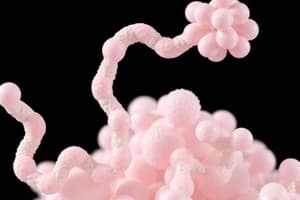Podcast
Questions and Answers
Which class of enzymes is specifically involved in oxidation-reduction reactions?
Which class of enzymes is specifically involved in oxidation-reduction reactions?
- Transferases
- Hydrolases
- Lyases
- Oxidoreductases (correct)
What is the functional unit of an enzyme composed of?
What is the functional unit of an enzyme composed of?
- Apoenzyme and coenzyme (correct)
- Enzyme and substrate
- Proenzyme and coenzyme
- Apoenzyme and cofactor
What term is used for enzymes that catalyze the joining of two molecules using ATP?
What term is used for enzymes that catalyze the joining of two molecules using ATP?
- Lyases
- Isomerases
- Ligases (correct)
- Hydrolases
Which technique allows for the incorporation of a specified amino acid at a predetermined position in a DNA molecule?
Which technique allows for the incorporation of a specified amino acid at a predetermined position in a DNA molecule?
What type of enzymes can be created by rearranging genes to produce fusion proteins?
What type of enzymes can be created by rearranging genes to produce fusion proteins?
What does the four-digit Enzyme Commission (E.C.) number represent?
What does the four-digit Enzyme Commission (E.C.) number represent?
Which enzymes are primarily responsible for hydrolysis reactions?
Which enzymes are primarily responsible for hydrolysis reactions?
Which element is NOT associated with the classification of enzymes?
Which element is NOT associated with the classification of enzymes?
Which property is true for all enzymes?
Which property is true for all enzymes?
What is the main purpose of modifying enzymes through genetic engineering?
What is the main purpose of modifying enzymes through genetic engineering?
Flashcards are hidden until you start studying
Study Notes
Classes of Enzymes
- Oxidoreductases: Facilitate oxidation-reduction reactions critical in metabolic pathways.
- Transferases: Catalyze the transfer of functional groups between molecules, playing a role in various biochemical processes.
- Hydrolases: Enzymes that catalyze hydrolysis, breaking down compounds by adding water.
- Lyases: Specialize in the addition or removal of groups such as water, ammonia, or carbon dioxide from substrates.
- Isomerases: Enzymes that catalyze isomerization reactions, leading to structural rearrangements within molecules.
- Ligases: Catalysts for synthetic reactions where two molecules are bonded together, often using ATP for energy.
Properties of Enzymes
- Enzymes are primarily proteins, although some RNA molecules have enzymatic functions.
- Each enzyme has a unique tertiary structure and conformation, essential for catalysis.
- The functional unit called holoenzyme consists of an apoenzyme (protein part) and a coenzyme (organic non-protein part).
Classification of Enzymes
- Each enzyme class contains sub-classes and further subdivisions.
- Unique Enzyme Commission (E.C.) numbers consist of four digits, designating class, sub-class, sub-sub class, and individual enzyme.
- Enzyme names reflect substrate, coenzyme (if applicable), and type of catalytic reaction.
- Complex IUB naming conventions are not widely adopted; trivial names and E.C. numbers are commonly used for simplicity.
Genetic Engineering and Modified Enzymes
- Advances in biotechnology enable enzyme modification for enhanced catalytic performance under various conditions.
- Modified enzymes hold significant potential for applications in medicine and industry.
Hybrid Enzymes
- Gene rearrangement can lead to the production of fusion proteins, such as hybrid enzymes that combine activities of glucanase and cellulase for improved hydrolysis of barley β-glucans during beer production.
Site-directed Mutagenesis
- This technique allows for specific mutations within a DNA molecule to introduce desired amino acids into an enzyme.
- Utilized to produce enzymes with tailored characteristics, exemplified by tissue plasminogen activator used for clot lysis in myocardial infarction.
Studying That Suits You
Use AI to generate personalized quizzes and flashcards to suit your learning preferences.




